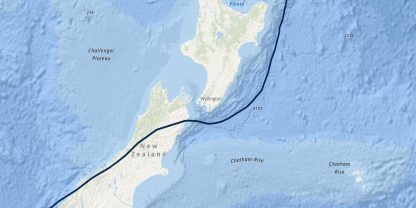Following the unprecedented and devastating weather events of 2023, much of the insurance industry’s focus has now shifted to resilience and mitigation of future weather related events. Research however is posing more questions than solutions.
Experts warn that New Zealand’s Hikurangi subduction zone poses a significant risk of a severe earthquake and tsunami.
If activated, this major geological fault could lead to an unprecedented disaster, causing substantial loss of life and property.
At a recent scientific conference at the Te Papa Museum, organized under the government-backed Resilience to Nature Challenge, scientists and disaster management experts explored the potential consequences of such an event.
The National Emergency Management Agency (NEMA) examined a scenario involving a 9.1 magnitude earthquake along the Hikurangi fault, followed by a tsunami.
“Science indicates that catastrophic events like an alpine fault earthquake or a Hikurangi subduction zone earthquake and tsunami are highly probable. They could occur in our lifetime, or our children’s,” said NEMA chief advisor Sarah Holland, speaking with Radio New Zealand.
Predictions indicate that such an earthquake could cause several minutes of ground shaking, significantly longer than the 2011 Canterbury earthquake.
Holland pointed out that, with a 70% successful evacuation rate, the resulting tsunami could kill over 22,000 people and injure around 26,000. Furthermore, up to 400,000 people could be displaced, with 30,000 homes damaged or destroyed, leading to an estimated $144 billion in building damages.
“This class of catastrophic events exceeds our current arrangements, thinking, and experience,” Holland said.
To prepare for such a dire scenario, NEMA is developing a disaster response plan in collaboration with about 50 organizations. This plan will serve as a handbook for various disasters and includes protocols for mass casualty management and the provision of essentials like food, water, and shelter.
Holland emphasized the necessity of international assistance for restoring critical infrastructure and emergency supply chains.
NEMA chief science advisor Tom Wilson noted that the urgency of robust preparedness measures has alerted officials and executives, particularly in the insurance industry.
“These are enormous numbers,” he said, as reported by RNZ. “This is what prompted change among chief executives.” Elected officials also took serious notice.
“We will be driven, perhaps reluctantly, by the insurance sector. However, we need a better platform to compare and characterize our risks and understand potential resilience strategies.”
A recent survey by insurer IAG New Zealand revealed that climate risks are increasingly influencing home-buying decisions in New Zealand, with more people considering climate change a significant factor compared to two years ago.
This month, a parliamentary inquiry on climate adaptation was launched in New Zealand, aiming to develop policies for managing climate change impacts.
Now more than ever, the value in advice provided by insurance intermediaries like the award winning team at O’Connor Warren becomes a necessity as opposed to a ‘nice-to-have’. Navigating insurer restrictions and retail banking hesitancy to lend on anything remotely earthquake or flood prone demands advisor assistance.


